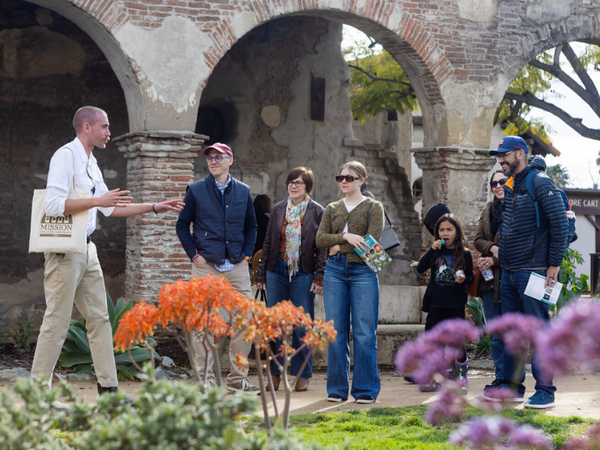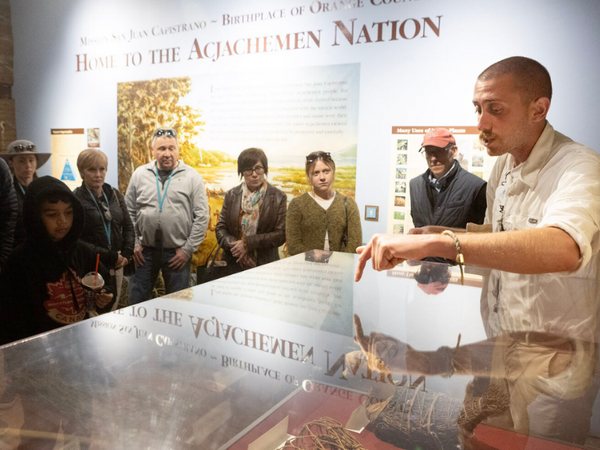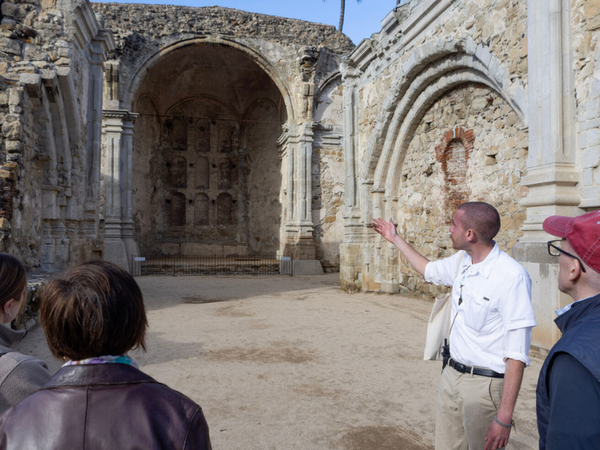For many, the repetition of reentering the same spaces can become a monotonous chore.
Not for C.J. Levin. Whenever the Mission San Juan Capistrano docent visits the historic grounds, it’s special. And she’s been doing it for decades.
“Every time I come in, I just feel better,” Levin said on a recent weekend at the Mission. Its VIP tour program was recently relaunched and is a wonderful offering that should be on anyone’s to-do list who loves local history and beautiful architecture.
The roughly 90-minute VIP tours are offered on Saturdays at 10 a.m. and Sundays at 2 p.m. through reservations at www.missionsjc.com/onsite-tours. Each guest receives a special memento.
“We are thrilled to bring back weekend guided tours after the program was curtailed by the impacts of the pandemic,” said Mission San Juan Capistrano Executive Director Mechelle Lawrence Adams. “We hope that guests will enjoy seeing the Mission up-close and more personally through this program, leaving with an even better perspective of the importance of this place.”
Tours are limited to groups of 25. The cost is $35 for adults and $30 for children.
The basic story of Mission San Juan Capistrano — dubbed the “Jewel of the Missions” — is well known to many. It was founded in 1776 by Spanish Catholics of the Franciscan Order. After falling into disrepair and changing ownership in the decades later, by the 20th century the Mission received considerable TLC to
become the jewel it is today.
Moreover, though it’s not the oldest of California’s 21 missions (that distinction belongs to Mission San Diego de Alcalá in 1769), Mission San Juan Capistrano is undoubtedly the most famous. That’s thanks to the legend of the swallows migrating there on St. Joseph’s Day — a story immortalized in pop culture, from the Ink Spots’ 1940 song to “Looney Tunes” antics.
That said, though many will know that basic history, VIP tours from guides like Levin will elevate appreciation for the historic site.
On the weekend of one recent tour, the sun was shining. The Mission was in its usual splendor. The bells tolled from the Mission Basilica, a thriving parish led by its pastor, Monsignor J. Michael McKiernan, that also boasts of a school. Scents wafted in from Heritage Barbecue across the street. It was a great day to stroll the grounds.
Levin introduced herself and learned that her tour — her fourth since the VIP program was resurrected — had coast-to-coast participants coming from Florida to Northern California.
The excursion began with a basic overview of mission history, noting the considerable shift in Spanish mentality from taking America’s resources to instead colonizing and evangelizing the native population.
Levin also pointed out the parallels of California history and the American colonies: Each coast was being taken over by European settlers around the same period.
Interestingly, that European history was far predated by the history of the Acjachemen, the indigenous people of the area whom the Spanish renamed Juaneños. Near the main entrance, Devin pointed out some grinding stones the hunter-gatherer Acjachemen used, presumably for thousands of years.
Moments like that, from a well-guided VIP tour, help bring the history and heritage of Mission San Juan Capistrano come alive.
Levin offered guests further factoids, like the 5,000 adobe bricks needed to construct a small room, or that fences didn’t surround the Mission until the early 20th century. There are even some cool firsts: California’s first chimney and vineyard, and its oldest existing metalworking structure.
In 1988, the American Society for Metals (now called ASM International) recognized the metalworking structure with a special historical plaque. Interestingly, the whole setup was lost to the elements for many years because it got covered up by sediment. It was rediscovered in the 1930s, Levin said.
“Many things happen by accident,” she added with a smile, soon admiring the greenery that contrasts that metalworking history. “We’re so proud of our gardens here.”
Later in the tour, the group learned about the imperfect dimensions of the buildings themselves — that was caused by imprecise tools and varied measuring styles — and the Mission’s connection to President Abraham Lincoln.
It concluded with a visit to the always-inspiring Serra Chapel — the site of another California-first factoid being the state’s oldest continually operated chapel — and the Ruins of the Great Stone Church.
The Serra Chapel alone has enough intricate, painstakingly crafted details to merit hours admiring it all, even though it’s a small space. The chapel has been expanded and restored over the decades, Devin explained.
“That’s what we are always trying to do here,” she concluded. “Preserve, conserve, dedicate.”



